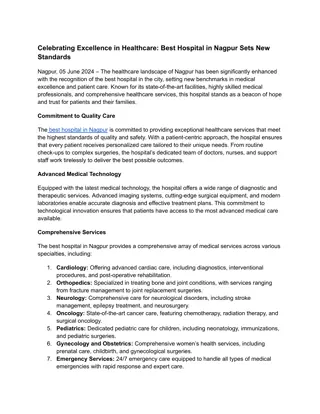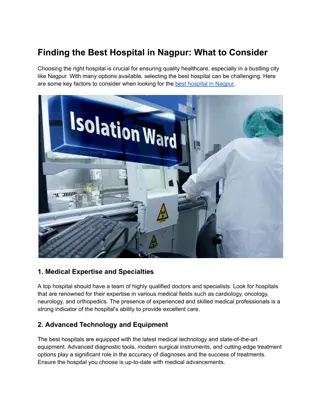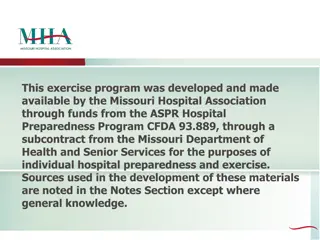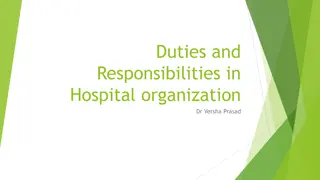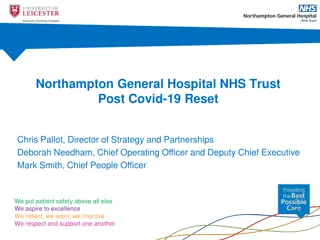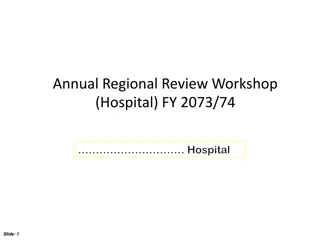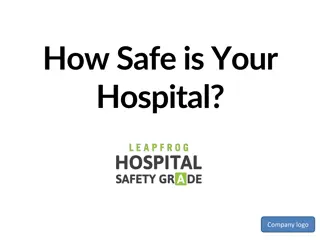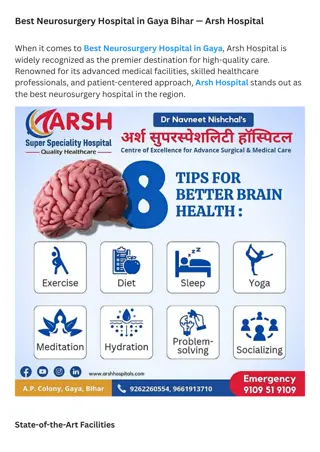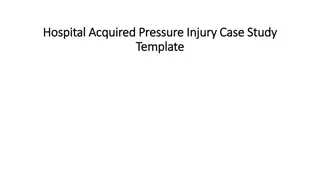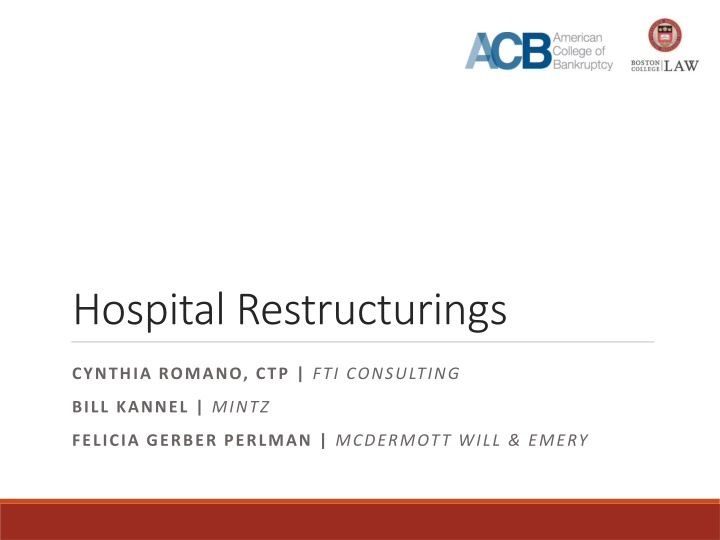
Healthcare Industry Challenges and Restructuring Insights
Explore the complexities of the healthcare industry, the broken healthcare system in the U.S., and the distress faced by hospitals and health systems. Gain insights into drivers of distress and obstacles to restructuring in the healthcare sector. Discover expert analyses and proprietary models to navigate these challenges effectively.
Download Presentation

Please find below an Image/Link to download the presentation.
The content on the website is provided AS IS for your information and personal use only. It may not be sold, licensed, or shared on other websites without obtaining consent from the author. If you encounter any issues during the download, it is possible that the publisher has removed the file from their server.
You are allowed to download the files provided on this website for personal or commercial use, subject to the condition that they are used lawfully. All files are the property of their respective owners.
The content on the website is provided AS IS for your information and personal use only. It may not be sold, licensed, or shared on other websites without obtaining consent from the author.
E N D
Presentation Transcript
Hospital Restructurings CYNTHIA ROMANO, CTP | FTI CONSULTING BILL KANNEL | MINTZ FELICIA GERBER PERLMAN | MCDERMOTT WILL & EMERY
Healthcare Overview Healthcare is made up of numerous subsectors that, each in their own right, is an industry. To talk about healthcare as a single industry doesn t capture the complexity of the ecosystem, despite commonalities. 2
Healthcare in the U.S. is Broken Expensive. We spend more on healthcare than any wealthy country ~5x higher than OECD countries In relative dollars, we spend ~17.3% of GDP on healthcare Ineffective. For all that money spent, we are not healthier or living longer. Life expectancy of the average American is 78.8 years We are only a fraction ahead of the Czech Republic, where out of pocket spend was $236 last year. Providers Failing. While money is being spent, large quantities of it, providers are still not making it. Health care bankruptcies in 2023 reached highest level in five years 2024 is expected to increase Consumers Failing. ~20% of Americans report having medical debt 62% of consumer bankruptcies are related to medical debt 3
FTI Consultings Proprietary Distressed Healthcare Debt Model As part of our ongoing industry practice, FTI Consulting monitors sector exposures. The following is non-investment grade/non-rated loans >$50 million Overall Exposure by Subsector 4
Hospitals and Health Systems in Crisis: Drivers of Distress Hospital distress puts lives at stake in acute care situations - actions that maximize liquidity are often at odds with patient needs and regulatory requirements. 2023 was troublesome. 2024 is expected to be worse. Total Healthcare Bankruptcies with >$25M in Liabilities[1] DRIVERS $ 15,000 50 CMS/payor reimbursement Number of Bankruptcies Liabilities ($B) 40 $ 10,000 30 Revenue cycle/AR 20 $ 5,000 10 Insurance/malpractice $ - 0 Continued impact of No Surprises Act Liabilities Number of Bankruptcies PE HC culture clash Physician alignment/engagement Quarterly Healthcare Bankruptcies with >$25M in Liabilities (1Q21-3Q23) 18 16 16 Number of Bankruptcies Loss leaders 14 12 10 10 High fixed assets 9 10 8 8 8 Ongoing labor pressures 5 5 6 3 3 3 4 2 Increased supply costs 2 0 High cost of capital 1Q21 2Q21 3Q21 4Q21 1Q22 2Q22 3Q22 4Q22 1Q23 2Q23 3Q23 4Q23 5
Hospitals and Health Systems in Crisis: Obstacles to Restructuring The drivers causing distress create obstacles to restructuring easily or successfully while the outlook continues to get increasingly dark. 2024 is expected to be worse than 2023. Probability of 1-Year Default (by U.S. Sector: June OBSTACLES 23 - Sep 23) Utilities Demographics Materials Size impact Financials Provider agreements Industrials Recoupment/setoff Consumer Staples Unions Energy Staffing agencies Physicians opting out Real Estate MAAP payments Information Technology NFP and faith-based considerations Consumer Discretionary HIPAA and data protection Communication Services Licensing Healthcare Asset risk (drugs, equipment) 0% 1% 2% 3% 4% 5% 6% Anti-consolidation sentiment Sep-23 Jun-23 6
Selected Features of Hospital Bankruptcies Financing Issues Political interference particularly in sale context Community impact Unions court visitors Patient care ombudsman HPITA The not for profit mission board duties Financing issues 7
Selected Features of Hospital Bankruptcies Financing Issues Equipment, Inventory, Intellectual Property, Real Estate Types of revenues Healthcare insurance receivables - just another species of account Self pay will they be part of the lenders borrowing base? Government payors - principally Medicare and Medicaid 8
Selected Features of Hospital Bankruptcies Financing Issues Government Payors 50% of revenues Recoupment / setoff recoupment has won Criminal and civil liability Anti Kickback / Stark Law strict liability False Claims Acts / Fraud and Abuse scienter Police or regulatory power stay exception 11 USC 362(b)(28) Transparent and proactive with CMS 9
Selected Features of Hospital Bankruptcies Financing Issues Anti-Assignment Provisions Technically a set of statutes and regulations Government has to pay the provider Very clear you can borrow against them Identifiable cash proceeds "double" or "bifurcated lockbox with a daily sweep 10
Selected Features of Hospital Bankruptcies Financing Issues The Grab Bag 11 USC 552(a) DIP Cash collateral Flop over / Replacement liens Diminution Are these accounts? DSH payments - disproportionate share payments Other government entitlements state or federal Going concern value Charitable assets 11
Selected Features of Hospital Bankruptcies Financing Issues More Grab Bag Bond financing Health Care Districts Chapter 9s 12
Fiduciary Duties A director of a nonprofit corporation must discharge his or her duties as a director or a member of a committee. When a nonprofit is insolvent the board of the nonprofit corporation, similar to the board of a for profit corporation, must consider the impact of their decisions on creditors. The fiduciary duties of nonprofit boards are governed by state law, some states specifically require that the nonprofit board balance its decisions with the need to focus on the charitable purpose of the organization. 13
Board Liability While some states have statutes limiting the liability of nonprofit board members others do not While historically courts had found that there must be a finding of fraud, bad faith, self dealing or other similar actions for a nonprofit board member to have liability, courts have now found that nonprofit board members can have liability breaching their fiduciary duties through negligence In In re Lemington Home for the Aged, the Third Circuit found the directors liable for failing to exercise reasonable prudence and care. Therefore, while caselaw in the nonprofit board context is not as developed or clear as that for for-profit boards, best practices suggest that nonprofit boards follow the same guidelines as for-profit boards in exercising their fiduciary duties, particularly when there are solvency concerns 14
The Absolute Priority Rule One of the requirements of the provisions governing plans of reorganization in Bankruptcy Code Section 1129(b) is that the plan must be fair and equitable. Section 1129(b)(2)(B) also provides a statutorily defined requirement of the fair and equitable rule as it is applied to unsecured creditors, referred to as the absolute priority rule, which essentially requires senior classes (such as general unsecured debt) to be paid in full before the equity interest holders retain or receive any property under the plan if the senior classes do not approve the plan. Though there are various ways to satisfy the absolute priority rule while allowing current equity interests holders to retain their interests, the absolute priority rule is intended to maximize the payment to creditors from the disposition of the debtor s property. 15
The Absolute Priority Rule In the case of a non-profit entity, however, there are no shareholders or equity interests. Therefore, courts often hold that the absolute priority rule is not applicable. However, in some circumstances, where there are other forms of ownership interests, courts have found that the absolute priority rule does apply. Courts often look to three factors: Control Profit sharing Ownership of corporate assets 16
Determining Course of Action: Sale or Restructuring Duty of Obedience In a sale of a nonprofit health care business s assets, the debtor must also consider whether the bids submitted further the institution s stated mission. Specifically, in addition to the duty of care and the duty of loyalty, directors of a nonprofit institution possess a duty of obedience to ensure compliance with the institution s mission, the governing documents of the organization, laws applicable to the organization and the restrictions imposed by donors to the organization. In the health care context, the consideration of public health, such as continuity of care for patients of a health care provider, might warrant approval of a sale even if there is a higher bidder or liquidation of the assets would provide more financial value to the estate. 17
Special Rules Involving Nonprofit Conversions Internal Revenue Code Considerations Many health care providers are nonprofit entities that qualify as tax-exempt organizations under 501(c)(3) of the Internal Revenue Code ( IRC ). In order to qualify as a tax-exempt entity, the health care organization must satisfy the strict operational and organizational requirements set forth in 501(c)(3) of the IRC. One of the requirements is that the entity must be organized and operated exclusively for charitable purposes, and its net earnings must be used to accomplish these purposes without inuring, in whole or in part, to the benefit of a private person. The assets of the tax- exempt entity are considered dedicated to the furtherance of its exempt purposes, and upon dissolution are to be distributed in a manner to further this purpose. A transfer of assets from a tax-exempt health care debtor to a taxable organization does not automatically result in the loss of tax-exempt status, but the Internal Revenue Service (IRS) will scrutinize the transaction to ensure that the debtor s tax-exempt purpose has not been compromised. If there is a material change in the character, purpose or method of the debtor s operation as a result of the sale, or if the use of its assets will be inconsistent with its tax-exempt purpose, the health care entity may lose its tax-exempt status and the debtor may be liable for certain taxes associated with the transaction. When conducting due diligence, the purchaser should consider whether its post-sale operations would fall within the debtor s tax-exempt purpose. The purchaser should ensure that the purchase price is arrived at via an arm s-length negotiation and that the purchaser will not engage in substantial lobbying or political campaigning, as is proscribed by 501(c)(3) of the IRC. 18
Special Rules Involving Nonprofit Conversions State Law Considerations Laws governing the transfer of health care assets vary from state to state. Some states have conversion laws that govern the transfer of nonprofit assets to a for-profit entity. Other states permit the attorney general to provide oversight of the conversion of nonprofit assets. It is also common for a state to require the attorney general to approve any transaction involving the sale of substantially all nonprofit health care assets. Guidelines differ, but in general, attorneys general will consider the following factors: (1) whether the terms and conditions of the proposed transaction are fair and reasonable to the non- profit corporation; (2) whether the proposed transaction will result in inurement to any private person or entity; (3) whether the proposed transaction provides a fair-market value to the non-profit; (4) whether the market value has been manipulated by the parties actions in a manner that causes the value to decrease; (5) whether the proposed use of the assets from the proposed transaction is consistent with the charitable trust or mission of the non-profit entity; (6) whether the proposed transaction constitutes a breach of trust; (7) how the proposed transaction affects the public; (8) whether the proposed transaction creates a significant effect on the availability or accessibility of health care services to the public; and (9) whether the proposed transaction is in the public interest. 19






